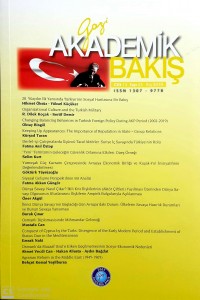Öz
Kaynakça
- ARREGUIN-TOFT, I. (2001). How Weak Win Wars: A Theory of Asymmetric Con¬flict. International Security, 26 (1): 93-128. CLARE, J. and Danilovic V. (2010). Multiple Audiencesand Reputation Building in International Conflicts. The Journal of Conflict Resolution, 54 (6): 860-82. CLARE, J. and Danilovic V. (2012). Reputation for Resolve, Interests, and Con¬flict. Conflict management and Peace Science, 29 (1): 3-27. CRESCENZI, M.J.C. and Enterline, A.J. (2001). Time Remembered: A Dynamic Model of Interstate Interaction. International Studies Quarterly, 45 (3): 409-431. CRESCENZI, M.J.C. (2007). Reputation and Interstate Conflict. American Journal of Political Science, 51 (2): 382-396. DIEHL, P. F., (Ed.). (1999). The Road Map to War: Territorial Dimensions of Interna¬tional Conflict. Nashville: Vanderbilt University Press. FEARON, J.D. (1997). Signaling Foreign Policy Interests: Tying Hands Versus Sinking Costs. Journal of Conflict Resolution, 41, 68-90. GEORGE, A., & Smoke, R. (1974). Deterrence in American Foreign Policy. New York: Columbia University Press. GOERTZ, G., & Diehl, P. (1992?)Territorial Changes and International Conflict. Lon¬don: Routledge. HUTH, P. K. (1996). Standing Your Ground: Territorial Disputes, 1950-1990. Ann Ar¬bor: University of Michigan Press. JERVIS, R. (1970). The Logic of Images in International Relations. Princeton: Princeton University Press. MACK, A. (1975). Why Big Nations Lose Small Wars: The Politics of Asymmet¬ric Conflict. World Politics, 27 (2): 175-200.
Öz
Over the past thirty years we observed a shift in conflict patterns where asymmetric conflicts increasingly became the norm. Building on the previous work on decision-making in asymmetric conflicts, this study compares two dominant hypotheses in the field, namely the reputation hypothesis and the capacity/inter¬est hypothesis, regarding adversaries’ conflict behavior in asymmetric conflicts. I argue that the reputa¬tion hypothesis is more useful than its bad track record in interstate conflicts suggests. I also contend that a single hypothesis is insufficient in explaining the decision-making behavior in asymmetric conflicts. In such conflicts, the uneven nature of power/status distribution between the actors leads them to have dissimilar goals and adopt different strategies. As a result, different hypotheses may be applicable to dif¬ferent actors. More specifically, the state as the more powerful of the two needs to protect its reputation in order to discourage any present and future challenges. The group, on the other hand, is often the weaker actor and its choices and strategies are limited by the availability of resources. This pushes them to behave according to capacity/interest hypothesis.
Anahtar Kelimeler
Asymmetric conflict crisis decision-making reputation capacity/interest
Kaynakça
- ARREGUIN-TOFT, I. (2001). How Weak Win Wars: A Theory of Asymmetric Con¬flict. International Security, 26 (1): 93-128. CLARE, J. and Danilovic V. (2010). Multiple Audiencesand Reputation Building in International Conflicts. The Journal of Conflict Resolution, 54 (6): 860-82. CLARE, J. and Danilovic V. (2012). Reputation for Resolve, Interests, and Con¬flict. Conflict management and Peace Science, 29 (1): 3-27. CRESCENZI, M.J.C. and Enterline, A.J. (2001). Time Remembered: A Dynamic Model of Interstate Interaction. International Studies Quarterly, 45 (3): 409-431. CRESCENZI, M.J.C. (2007). Reputation and Interstate Conflict. American Journal of Political Science, 51 (2): 382-396. DIEHL, P. F., (Ed.). (1999). The Road Map to War: Territorial Dimensions of Interna¬tional Conflict. Nashville: Vanderbilt University Press. FEARON, J.D. (1997). Signaling Foreign Policy Interests: Tying Hands Versus Sinking Costs. Journal of Conflict Resolution, 41, 68-90. GEORGE, A., & Smoke, R. (1974). Deterrence in American Foreign Policy. New York: Columbia University Press. GOERTZ, G., & Diehl, P. (1992?)Territorial Changes and International Conflict. Lon¬don: Routledge. HUTH, P. K. (1996). Standing Your Ground: Territorial Disputes, 1950-1990. Ann Ar¬bor: University of Michigan Press. JERVIS, R. (1970). The Logic of Images in International Relations. Princeton: Princeton University Press. MACK, A. (1975). Why Big Nations Lose Small Wars: The Politics of Asymmet¬ric Conflict. World Politics, 27 (2): 175-200.
Ayrıntılar
| Birincil Dil | İngilizce |
|---|---|
| Bölüm | Makaleler |
| Yazarlar | |
| Yayımlanma Tarihi | 13 Aralık 2019 |
| Yayımlandığı Sayı | Yıl 2019 Cilt: 13 Sayı: 25 |
Kaynak Göster
Gazi Akademik Bakış Dergisi Creative Commons Atıf-GayriTicari 4.0 Uluslararası Lisansı ile lisanslanmıştır.


